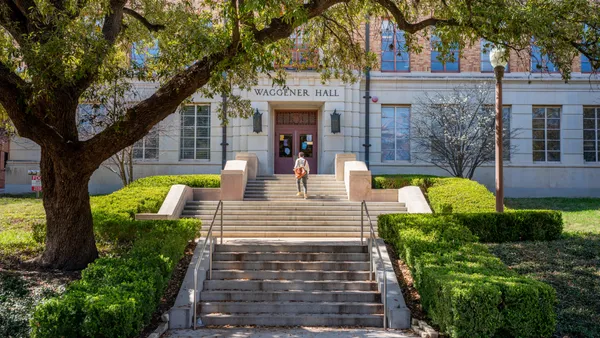CHICAGO — When online education entered the scene more than two decades ago, its critics predicted it would dampen the quality of college instruction. Today, the sector has shed some of those concerns, with about one-third of students taking at least one course online.
Yet there's still room for improvement. Researchers have found that fully online programs and classes may contribute to equity gaps and lead to poorer outcomes for the least prepared students.
But there are some bright spots, according to speakers at Educause's annual conference in Chicago. Innovative models for online classroom instruction could be poised to help the sector live up to its goals of expanding college access and making learning possible anywhere.
Below, we share how several administrators are moving online education forward at their institutions.
Prepping students for online courses
At California State University Channel Islands, a midsize institution located about an hour's drive from Los Angeles, officials wanted to proactively teach students the skills needed to thrive in online classes. So in 2018, they rolled out a self-paced course called Learning Online 101.
The one-to-three-hour class allows students to practice using the technology required in online courses in a low-stakes environment while also teaching the importance of time management and a strong support network.
Officials also sprinkled throughout the course photos of the campus and video messages from the president, faculty and students to help online learners feel more connected with the community.
"The humanization of the course was really important," said Jill Leafstedt, the university's associate vice provost of innovation and faculty development. Students taking online classes "are working full time, they have families, they have caretaker responsibilities, so they're not on campus to create that connection."
About 1,000 students have taken the course so far. Of those, about half (54%) were first-generation students and more than two-thirds (68%) had taken an online class before. Nearly all of the students (92%) said the course "increased their confidence for learning online."
Next steps include studying whether the course impacts student performance and reduces the number of technical questions faculty receive, officials said.
Bringing high-impact practices online
More than a decade ago, the Association of American Colleges & Universities unveiled its list of high-impact educational practices — such as study abroad, writing-intensive courses and undergraduate research — which some studies suggest boost student outcomes, especially for underserved populations.
Yet many of these practices are difficult, if not impossible, to carry over into an online environment. Take the high-impact practice of service-learning, which typically involves completing a field-based project for a community partner. Biology students, for instance, may plant trees with a local conservation group to reinforce their in-class instruction about biodiversity.
But Jaci Lindberg, director of digital learning at the University of Nebraska at Omaha, was determined to incorporate service-learning into her online gender and leadership class.
Her first few attempts involved requiring students to show up in-person to complete a service-learning project, such as helping organize a women's leadership conference. But the students were pushing back, with many saying they didn't have someone to watch their kids or couldn't take off work on the day of the project.
"The humanization of the course was really important. [Online students] are working full-time, they have families, they have caretaker responsibilities, so they're not on campus to create that connection."

Jill Leafstedt
Associate vice provost of innovation and faculty development, CSU Channel Islands
Lindberg knew she needed a different approach.
"I need to meet my students where they are," she said. "They're picking an online course for a reason … so I started to think to myself, 'How can I grab a partner or opportunity that is also online for them but still allows them to have a pretty transformational experience?'"
Now, the course's required service-learning project is completely online, with students creating webpages that help build out an archive about leaders who have worked toward gender equality for their community partner, Girls Inc.
"No one has asked for an exception, and I feel like they've really leaned into the project," Lindberg said. "I got the transformation that I was really seeking for the students to have."
Bringing together residential and remote students
Thanks to the growing popularity of online learning, Harvard University's Extension School has seen a recent surge in students, with enrollment passing 30,000 in the 2017-18 academic year.
The school has responded to that growth by ramping up its online offerings — Harvard's Division of Continuing Education is offering 840 online classes in 2019 — but officials wanted to do more to build a community between campus-based and remote learners.
For many years, one of the school's only options was livestreaming in-person classes to distance students — a workaround officials found insufficient.
"Ideally, if everything comes together in the right way, the technology can fade to the background and become somewhat of an afterthought."

Christian Franco
Manager of live interactive learning technology, Harvard University
"It was more like a passive window to the classroom," said Christian Franco, Harvard's manager of live interactive learning technology. "There's no feeling of community, there's no timely way to ask a question or be part of the session. Simply put, online students really didn't have a voice."
The solution? A new course format called HELIX, which lets students choose whether they want to participate in live classes online or in person. To do so, classes were outfitted with multiple cameras to capture the lecture and large televisions in the back and front of the room that display remote students on a split-screen (similar to the opening credits of the TV show "The Brady Bunch").
Moreover, teachers have a direct sight line to the television in the back of the room, so they can see remote learners raise their hands and call on them in the same manner they do in-person students. "Ideally, if everything comes together in the right way, the technology can fade to the background and become somewhat of an afterthought," Franco said.






















